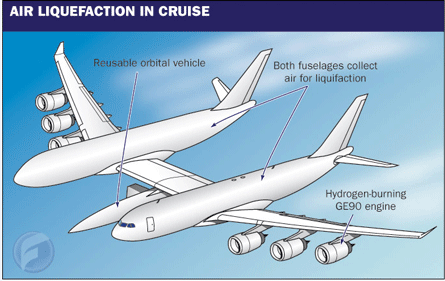In-flight oxidiser collection possible, says ESA study
A European Space Agency-funded study has concluded that air liquefaction plants for a space transportation system's first-stage carrier aircraft are possible within the mass limits required.
The first stage would collect air, liquefy it and separate the nitrogen, producing 10kg/s (22lb/s) with a 10,000kg (22,000lb) on-board liquefaction plant.
The advantage of such a system is that the preferred liquid-oxygen propellant does not have to be carried from the ground. Once collected, the oxygen-enriched liquefied air is stored in the second-stage reusable orbiter vehicle.

The plant's main mass drivers are the heat exchangers, of which there would be three. These have been a focus of the ESA study.
The study, involving Universite Libre de Bruxelles (ULB), developed the two-stage launch system concept that incorporates liquefaction.
That system has a dual-hull, hydrogen-fuelled aircraft using six General Electric 90b engines as the carrier aircraft. Between its two fuselages under the wing, it would carry an orbiter vehicle fuelled only with liquid hydrogen with a total mass of 90,000kg.
Taking off from the 15,000ft (4,575m) runway at the Vandenberg US Air Force base in California, the gross lift-off weight would be 1,035,000kg.
It would cruise for 6,250km (3,378nm), during which it supersonically collects the air, out to the middle of the Pacific. At that point, the carrier aircraft would perform a 1.5g manoeuvre to drop the orbiter.
By the separation point, the orbiter would have been filled with 210,000kg of liquefied enriched air. Because it is not pure liquid oxygen, 2-3s in specific impulse is lost for every percentage point reduction in purity.
Gases such as argon, which would be 6% of the liquefied air mass, are considered too difficult to separate.
"ESA funded this under its general studies programme," says ULB researcher Dries Verstraete. "We are continuing to work on the collection plant. This is possible using today's or near-future technologies."
Verstraete says the researchers had compared their first-stage carrier aircraft design and mass with a similar Russian vehicle called Herakles and found them to be comparable.
His team also contacted the US Air Force researchers working on their own system (Flight International, 25 April - 1 May 2006), but there has been little communication.
Related story
Source: Flight International























